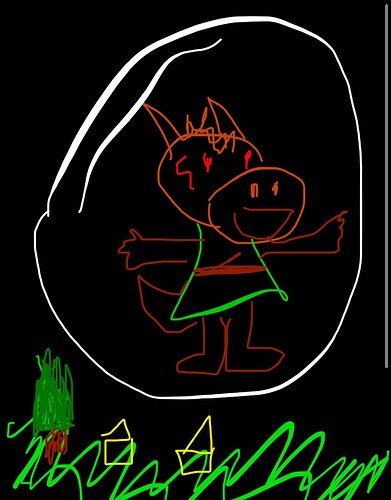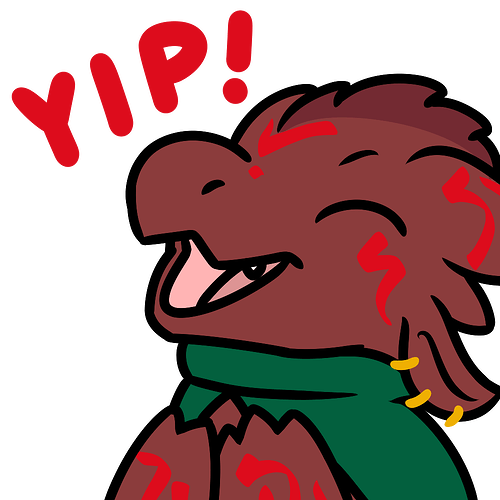wyx (they/them)
wyx is a small-sized brown-scaled kobold who wears a green tunic, shawl, and leather armor. They have horns that curve backwards, one of which is adorned with a gold ring, and ears that are pierced and adorned with 3 gold earrings on either side. Under the earrings, wyx’s ears are ripped and healed long ago, so it’s hard to tell they were ever damaged. wyx’s tail is relatively long for a kobold, but not too big, and adorned with a large golden ring just under their tunic.
Scrawled across the kobold’s body are faintly glowing red arcane runes. While they last a long time, wyx redraws them every day, ensuring they have enough power to function as a limiter that prevents them from being automatically drafted into The Skeleton War. Due to this high level of magic required to ward off the divine draft, wyx is typically only capable of up to 3rd or 4th level spells.
wyx’s favorite pastimes are:
- Helping adventurers
- Brewing potions
- Committing crimes & tricks
- Exploring abandoned ruins to search for treasure
- Buying, selling, trading, and loaning magical items
- Befriending & taking care of animals
- Pacifism
In general, they have access to a ludicrous amount of gear in various bags and boxes of holding.
wyx is often seen with their materialized phantasmal steed, Chomps the giant turtle, who is capable of moving very fast despite his size. The turtle is often seen carrying the kobold’s gear, but sometimes wyx stores the goods in their personal pocket dimension so Chomps can get a break.
race: kobold (Loredrake)
class: rogue (arcane trickster) 15
Stats
Proficiency Bonus +5 – Spell Save DC 16
HP: 86 / AC: 18 – STR 10 DEX 16 CON 12 INT 16 WIS 10 CHA 20
Saving Throws: STR +1 DEX +9 CON +1 INT +9 WIS +6 CHA +5
Languages Common, Draconic, Undercommon, Orc
Equipment
Attuned: Ring of Free Action
Attuned: Pearl of Power
Attuned: Cloak of Protection
Studded Leather Armor +2
Wand of Secrets: 3 charges, regain 1d3 at dawn
Ring of Animal Influence: 3 charges, regain 1d3 at dawn
Animal friendship (save DC 13), Fear (save DC 13), targeting only beasts that have an
Intelligence of 3 or lower, Speak with animals
Bag of Holding
Items
- Potion of Healing (2d4+2) x5
Proficiencies
Armor: Light armor
Weapons: Simple weapons, hand crossbows, longswords, rapiers, shortswords
Tools: Thieves’ tools (Expertise), Alchemist’s Tools
Saving Throws: Dexterity, Intelligence, Wisdom
Skills: Animal Handling (Exp) +10, Arcana +8, Perception (Exp) +10, Persuasion +10, Sleight of Hand +8, Stealth (Exp) +13
Spellcasting
Spell Slots – 1: 4/4 – 2: 3/3 – 3: 2/2
Spells Known
Cantrips
- Mage Hand
- Prestidigitation
- Mending
- Minor Illusion
- Dancing Lights
- Light (Sorcerer via Loredrake)
- Message (Sorcerer via Loredrake)
Spell Level 1
- Tenser’s Floating Disk
- Silvery Barbs
- Disguise Self (by Shadow Touched, uses Cha, can cast 1/long rest for free)
- Color Spray
- Cure Wounds (by Artificer Initiate, uses Int, can cast 1/long rest for free)
- Silent Image
- Detect Magic (Sorcerer via Loredrake, uses Cha, can cast 1/long rest for free)
Spell Level 2
- Rope Trick
- Invisibility (by Shadow Touched, uses Cha, can cast 1/long rest for free)
- Magic Mouth
- Nystul’s Magic Aura
- Suggestion
Spell Level 3
- Phantom Steed
- Glyph of Warding
- Major Image
Race: Kobold (Loredrake)
A little reptilian race with a strong social structure that stresses devotion to the tribe.
Ability Score Increase. Your Dexterity score increases by 2.
Age. Once hatched, kobolds mature at a breakneck pace. By the time a kobold reaches 7 or 8 years old, on average, they are mentally and physically capable to assist the tribe in some capacity. Kobolds can live to be over 120 years old, but usually die to external causes well before then.
Alignment. Kobolds are fiercely loyal to their tribe. Thus, they tend toward lawful alignments.
Size. Kobolds are diminutive creatures, virtually never reaching over 3 feet tall. Your size is Small.
Speed. Your base walking speed is 30 feet.
Darkvision. You can see in dim light within 60 feet of you as if it were bright light, and in darkness as if it were dim light. You can’t discern color in darkness, only shades of gray.
Pack Tactics. You have advantage on an attack roll against a creature if at least one of your allies is within 5 feet of the creature and the ally isn’t incapacitated.
Slim Build. You count as one size smaller when determining your carrying capacity and the weight you can push, drag, or lift.
Sunlight Sensitivity. You have disadvantage on attack rolls and Wisdom (Perception) checks that rely on sight whenever you, the target of your attack, or whatever you are trying to perceive is in direct sunlight.
Languages. You can speak, read, and write Common and Draconic.
Subrace: Loredrake Kobold
Ability Score Increase. Your Charisma score increases by 1.
Sorcerous Initiate. You know 2 cantrips of your choice from the sorcerer spell list. In addition, you know one 1st-level spell from the Sorcerer spell list. You can cast this spell once, regaining the ability to cast it when you complete a long rest. Charisma is your spellcasting ability for these spells.
Class: Rogue
| 1st | +2 | 1d6 | Expertise, Sneak Attack, Thieves’ Cant |
|---|---|---|---|
| 2nd | +2 | 1d6 | Cunning Action |
| 3rd | +2 | 2d6 | Roguish Archetype, Steady Aim (Optional) |
| 4th | +2 | 2d6 | Ability Score Improvement |
| 5th | +3 | 3d6 | Uncanny Dodge |
| 6th | +3 | 3d6 | Expertise |
| 7th | +3 | 4d6 | Evasion |
| 8th | +3 | 4d6 | Ability Score Improvement |
| 9th | +4 | 5d6 | Roguish Archetype feature |
| 10th | +4 | 5d6 | Ability Score Improvement |
| 11th | +4 | 6d6 | Reliable Talent |
| 12th | +4 | 6d6 | Ability Score Improvement |
| 13th | +5 | 7d6 | Roguish Archetype feature |
| 14th | +5 | 7d6 | Blindsense |
| 15th | +5 | 8d6 | Slippery Mind |
Background: Fantastic Creature Apprentice
Similar to Sage background.
You were raised by a wizard, surrounded by fantastic creatures and without any magic of your own. Despite your lack of magic, you picked up many tricks, and bonded with the animals your teacher tamed, and by the time you left, you were able to cobble together from your teacher’s notes how to summon a familiar, though without further training than your background you doubt you’d be able to do it again.
Skill Proficiencies: Animal Handling, Arcana
Languages: Two of your choice
Equipment: A bottle of black ink, a quill, a small knife, a scroll of find familiar that only you can use, a set of common clothes, and a pouch containing 10 gp
Feature: Researcher
When you attempt to learn or recall a piece of lore, if you do not know that information, you often know where and from whom you can obtain it. Usually, this information comes from a library, scriptorium, university, or a sage or other learned person or creature. Your DM might rule that the knowledge you seek is secreted away in an almost inaccessible place, or that it simply cannot be found. Unearthing the deepest secrets of the multiverse can require an adventure or even a whole campaign.
Class Features
As a rogue, you gain the following class features.
Hit Dice: 1d8 per rogue level
Hit Points at 1st Level: 8 + your Constitution modifier
Hit Points at Higher Levels: 1d8 (or 5) + your Constitution modifier per rogue level after 1st
Proficiencies
Armor: Light armor
Weapons: Simple weapons, hand crossbows, longswords, rapiers, shortswords
Tools: Thieves’ tools
Saving Throws: Dexterity, Intelligence
Skills: Choose four from Acrobatics, Athletics, Deception, Insight, Intimidation, Investigation, Perception, Performance, Persuasion, Sleight of Hand, and Stealth
Equipment
You start with the following equipment, in addition to the equipment granted by your background:
- (a) a rapier or (b) a shortsword
- (a) a shortbow and quiver of 20 arrows or (b) a shortsword
- (a) a burglar’s pack, (b) dungeoneer’s pack, or (c) an explorer’s pack
- Leather armor, two daggers, and thieves’ tools
Expertise
At 1st level, choose two of your skill proficiencies, or one of your skill proficiencies and your proficiency with thieves’ tools. Your proficiency bonus is doubled for any ability check you make that uses either of the chosen proficiencies.
At 6th level, you can choose two more of your proficiencies (in skills or with thieves’ tools) to gain this benefit.
Sneak Attack
Beginning at 1st level, you know how to strike subtly and exploit a foe’s distraction. Once per turn, you can deal an extra 1d6 damage to one creature you hit with an attack if you have advantage on the attack roll. The attack must use a finesse or a ranged weapon.
You don’t need advantage on the attack roll if another enemy of the target is within 5 feet of it, that enemy isn’t incapacitated, and you don’t have disadvantage on the attack roll.
The amount of the extra damage increases as you gain levels in this class, as shown in the Sneak Attack column of the Rogue table.
Thieves’ Cant
During your rogue training you learned thieves’ cant, a secret mix of dialect, jargon, and code that allows you to hide messages in seemingly normal conversation. Only another creature that knows thieves’ cant understands such messages. It takes four times longer to convey such a message than it does to speak the same idea plainly.
In addition, you understand a set of secret signs and symbols used to convey short, simple messages, such as whether an area is dangerous or the territory of a thieves’ guild, whether loot is nearby, or whether the people in an area are easy marks or will provide a safe house for thieves on the run.
Cunning Action
Starting at 2nd level, your quick thinking and agility allow you to move and act quickly. You can take a bonus action on each of your turns in combat. This action can be used only to take the Dash, Disengage, or Hide action.
Archetype: Arcane Trickster
At 3rd level, you choose an archetype that you emulate in the exercise of your rogue abilities. Your archetype choice grants you features at 3rd level and then again at 9th, 13th, and 17th level.
Arcane Trickster Spellcasting Spell Slots per Spell Level
Rogue Level Cantrips Known Spells Known 1st 2nd 3rd 4th
15th Mage Hand + 3 10 4 3 2 -
Spellcasting
When you reach 3rd level, you augment your martial prowess with the ability to cast spells.
Cantrips
You learn three cantrips: Mage Hand and two other cantrips of your choice from the wizard spell list. You learn another wizard cantrip of your choice at 10th level.
Spell Slots
The Arcane Trickster Spellcasting table shows how many spell slots you have to cast your wizard spells of 1st level and higher. To cast one of these spells, you must expend a slot of the spell’s level or higher. You regain all expended spell slots when you finish a long rest.
For example, if you know the 1st-level spell Charm Person and have a 1st-level and a 2nd-level spell slot available, you can cast Charm Person using either slot.
Spells Known of 1st Level and Higher
You know three 1st-level wizard spells of your choice, two of which you must choose from the enchantment and illusion spells on the wizard spell list.
The Spells Known column of the Arcane Trickster Spellcasting table shows when you learn more wizard spells of 1st level or higher. Each of these spells must be an enchantment or illusion spell of your choice, and must be of a level for which you have spell slots. For instance, when you reach 7th level in this class, you can learn one new spell of 1st or 2nd level.
The spells you learn at 8th, 14th, and 20th level can come from any school of magic.
Whenever you gain a level in this class, you can replace one of the wizard spells you know with another spell of your choice from the wizard spell list. The new spell must be of a level for which you have spell slots, and it must be an enchantment or illusion spell, unless you’re replacing the spell you gained at 3rd, 8th, 14th, or 20th level from any school of magic.
Spellcasting Ability
Intelligence is your spellcasting ability for your wizard spells, since you learn your spells through dedicated study and memorization. You use your Intelligence whenever a spell refers to your spellcasting ability. In addition, you use your Intelligence modifier when setting the saving throw DC for a wizard spell you cast and when making an attack roll with one.
Spell save DC = 8 + your proficiency bonus + your Intelligence modifier
Spell attack modifier = your proficiency bonus + your Intelligence modifier
Mage Hand Legerdemain
Starting at 3rd level, when you cast Mage Hand, you can make the spectral hand invisible, and you can perform the following additional tasks with it:
-
You can stow one object the hand is holding in a container worn or carried by another creature.
-
You can retrieve an object in a container worn or carried by another creature.
-
You can use thieves’ tools to pick locks and disarm traps at range.
You can perform one of these tasks without being noticed by a creature if you succeed on a Dexterity (Sleight of Hand) check contested by the creature’s Wisdom (Perception) check.
In addition, you can use the bonus action granted by your Cunning Action to control the hand.
Magical Ambush
Starting at 9th level, if you are hidden from a creature when you cast a spell on it, the creature has disadvantage on any saving throw it makes against the spell this turn.
Versatile Trickster
At 13th level, you gain the ability to distract targets with your Mage Hand. As a bonus action on your turn, you can designate a creature within 5 feet of the spectral hand created by the spell. Doing so gives you advantage on attack rolls against that creature until the end of the turn.
Steady Aim (Optional)
At 3rd level, as a bonus action, you give yourself advantage on your next attack roll on the current turn. You can use this bonus action only if you haven’t moved during this turn, and after you use the bonus action, your speed is 0 until the end of the current turn.
Ability Score Improvement
When you reach 4th level, and again at 8th, 10th, 12th, 16th, and 19th level, you can increase one ability score of your choice by 2, or you can increase two ability scores of your choice by 1. As normal, you can’t increase an ability score above 20 using this feature.
4: Shadow Touched: +1 Cha,
8: Artificer’s Initiate: Dancing Lights cantrip, Cure Wounds 1st level, Alchemist’s Supplies
10: +2 Dex
12: Unique Feat: Benign Kobold – Creatures that are instinctively violent towards you are instead neutral, and will not attack you unless you perform a hostile action towards them. You can use Animal Handling, Deception, Intimidate, and Persuasion on them. Skills used this way may be treated as hostile per the game master.
Uncanny Dodge
Starting at 5th level, when an attacker that you can see hits you with an attack, you can use your reaction to halve the attack’s damage against you.
Evasion
Beginning at 7th level, you can nimbly dodge out of the way of certain area effects, such as a red dragon’s fiery breath or an Ice Storm spell. When you are subjected to an effect that allows you to make a Dexterity saving throw to take only half damage, you instead take no damage if you succeed on the saving throw, and only half damage if you fail.
Reliable Talent
By 11th level, you have refined your chosen skills until they approach perfection. Whenever you make an ability check that lets you add your proficiency bonus, you can treat a d20 roll of 9 or lower as a 10.
Blindsense
Starting at 14th level, if you are able to hear, you are aware of the location of any hidden or invisible creature within 10 feet of you.
Slippery Mind
By 15th level, you have acquired greater mental strength. You gain proficiency in Wisdom saving throws.





























































